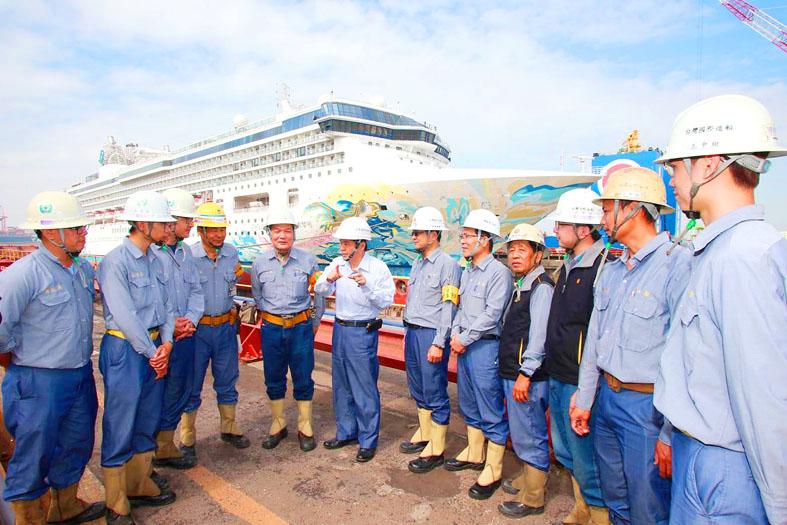CSBC Corp, Taiwan (台船) yesterday reported a pretax profit of NT$34 million (US$1.2 million) for last quarter, ending five consecutive quarters of losses.
The turnaround could be attributed to cost improvements and lower foreign exchange volatility, a CSBC official told the Taipei Times by telephone.
Although the shipbuilder’s revenue fell 17.65 percent annually to NT$4.52 billion in the first quarter, its costs dropped at an even faster rate, thanks to production improvements at its two plants in Keelung and Kaohsiung.

Photo courtesy of CSBC Corp, Taiwan
As a result, its gross margin returned to positive territory last quarter, the official said.
Last year, it reported a gross margin of minus-5.57 percent as its cost of goods sold exceeded total sales, company data showed.
Aside from cost reductions, the appreciation of the New Taiwan dollar against the US dollar moderated in the first quarter compared with a year earlier, resulting in lower foreign-exchange losses, CSBC said.
As most orders CSBC obtained from shippers, such as Yang Ming Marine Transport Corp (陽明海運), to build commercial vessels are denominated in the greenback, the local currency’s appreciation affects its revenue significantly, the official said.
Last quarter, CSBC delivered a new vessel with capacity of 2,800 twenty-foot equivalent units to Yang Ming, and plans to deliver another two vessels by the end of this year, the official said.
“The revenue generated from the US dollar-denominated vessels orders would account for a smaller share of our total sales by the end of this year, as we are shifting our focus to military vessels for the Ministry of National Defense and marine constructions for offshore wind farms,” the official said.
As a result, foreign-exchange rate volatility is expected to have a weaker impact on CSBC’s sales going forward, the official said.
Revenue from orders from the ministry accounted for 60 percent of the company’s total sales in the first quarter, while those from the commercial vessels and marine constructions accounted for the remaining 40 percent, CSBC said.

TECH BOOST: New TSMC wafer fabs in Arizona are to dramatically improve US advanced chip production, a report by market research firm TrendForce said With Taiwan Semiconductor Manufacturing Co (TSMC, 台積電) pouring large funds into Arizona, the US is expected to see an improvement in its status to become the second-largest maker of advanced semiconductors in 2027, Taipei-based market researcher TrendForce Corp (集邦科技) said in a report last week. TrendForce estimates the US would account for a 21 percent share in the global advanced integrated circuit (IC) production market by 2027, sharply up from the current 9 percent, as TSMC is investing US$65 billion to build three wafer fabs in Arizona, the report said. TrendForce defined the advanced chipmaking processes as the 7-nanometer process or more

China’s Huawei Technologies Co (華為) plans to start mass-producing its most advanced artificial intelligence (AI) chip in the first quarter of next year, even as it struggles to make enough chips due to US restrictions, two people familiar with the matter said. The telecoms conglomerate has sent samples of the Ascend 910C — its newest chip, meant to rival those made by US chipmaker Nvidia Corp — to some technology firms and started taking orders, the sources told Reuters. The 910C is being made by top Chinese contract chipmaker Semiconductor Manufacturing International Corp (SMIC, 中芯) on its N+2 process, but a lack

NVIDIA PLATFORM: Hon Hai’s Mexican facility is to begin production early next year and a Taiwan site is to enter production next month, Nvidia wrote on its blog Hon Hai Precision Industry Co (鴻海精密), the world’s biggest electronics manufacturer, yesterday said it is expanding production capacity of artificial intelligence (AI) servers based on Nvidia Corp’s Blackwell chips in Taiwan, the US and Mexico to cope with rising demand. Hon Hai’s new AI-enabled factories are to use Nvidia’s Omnivores platform to create 3D digital twins to plan and simulate automated production lines at a factory in Hsinchu, the company said in a statement. Nvidia’s Omnivores platform is for developing industrial AI simulation applications and helps bring facilities online faster. Hon Hai’s Mexican facility is to begin production early next year and the

Who would not want a social media audience that grows without new content? During the three years she paused production of her short do-it-yourself (DIY) farmer’s lifestyle videos, Chinese vlogger Li Ziqi (李子柒), 34, has seen her YouTube subscribers increase to 20.2 million from about 14 million. While YouTube is banned in China, her fan base there — although not the size of YouTube’s MrBeast, who has 330 million subscribers — is close to 100 million across the country’s social media platforms Douyin (抖音), Sina Weibo (新浪微博) and Xiaohongshu (小紅書). When Li finally released new videos last week — ending what has